The main difference between a manta ray and a stingray is their shape and size. Manta rays have triangular-shaped bodies and are larger in size, while stingrays have flat, disc-shaped bodies and are smaller.
Additionally, manta rays do not have stingers on their tails like stingrays do, and they feed mainly on plankton, while stingrays feed on small fish and crustaceans.
However, manta Rays and Sting Rays are one of the most significant creatures that live in the sea. Both creatures are completely different species of fish, and just because they look very familiar, they are considered to be the same fish.
In this article, I will tell you about the differences between a Manta Ray and a Sting Ray and how you can differentiate between them.
Stingray vs Manta ray: A Comparison Table
| Feature | Manta-Ray | Sting Ray |
| Size | Can reach up to 23 feet | Can reach up to 8 feet |
| Habitat | Warmer and subtropical waters | Seafloor or coastal waters |
| Mouth location | Front Edge | Underside of its body |
| Average Age | 30-40 years | 15 to 25 years |
| Tail | Does not contain a barb | Contains a spine |
| Mating Season | October, November, March, April | May-July |
| Fin location | On their heads | Mid area of the tail |
| Weight | Up to 2980 pounds | Up to 800 pounds |
| Diet | Planktons, Krill, etc. | Crustaceans and other invertebrates |
Stingray vs Manta ray: Key Differences
Size
Manta and stingrays are two distinct species of rays in the world’s oceans. Manta rays are typically larger than stingrays, can grow up to 23 feet in width, and weigh up to 3000 pounds. However, a giant manta ray can be 29 feet in size.
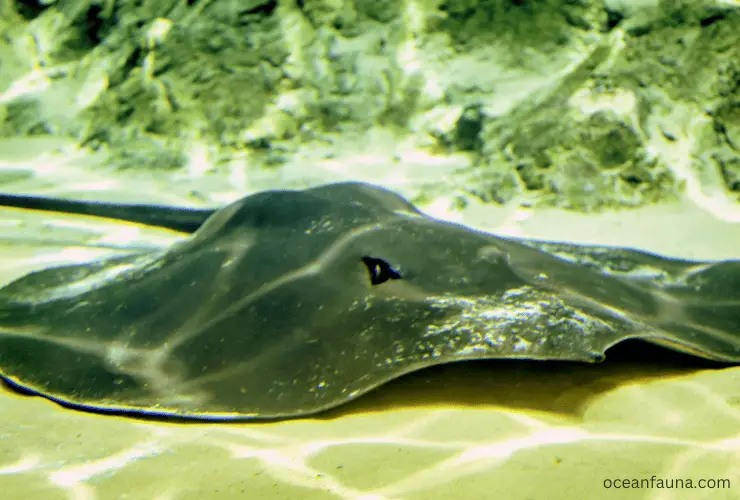
But, stingrays are smaller, with a maximum width of about 8 feet and around 800 pounds. The difference in size can also be seen in their shapes, with manta rays having broader, flatter bodies and stingrays having more rounded bodies.
Additionally, manta rays have larger fins and a more prominent head compared to stingrays.
Tail
The tails of manta rays and stingrays are quite different. Manta rays have a small, rounded tails not used for defense, while stingrays have long, slender tails equipped with a stinger.
A stingray’s stinger is used primarily for defense and is covered in toxic venom. A stingray can use its tail to deliver a painful sting if it feels threatened. This sting can cause severe pain, swelling, and even paralysis, but it is rarely fatal to humans.
In contrast, manta rays do not have stingers and are not dangerous to humans.
Instead, they use their tails for propulsion and maneuverability. The tails of manta rays are shorter and more rounded than those of stingrays and are typically less noticeable due to their larger size.
In short, while the tails of manta and stingrays serve different purposes, they are essential adaptations that help these animals thrive in their respective environments.
Shape and Appearance
Manta rays and stingrays differ significantly in terms of their shape and appearance. Manta rays are characterized by their large, flat bodies, broad fins, and prominent heads resembling a bat’s shape.
Their dorsal side is smooth, black, or dark-colored, and their ventral side is white or light-colored. Their distinctive shape aids in efficient filter feeding on plankton and small fish.
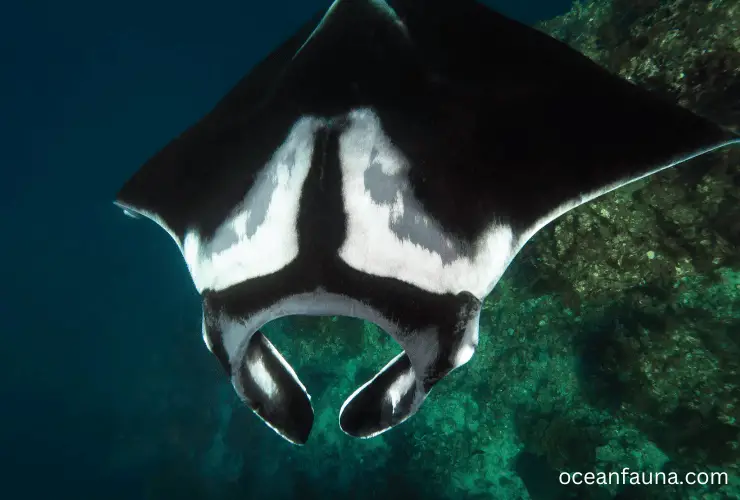
On the other hand, stingrays have a more rounded, disk-like shape. They have a flat body with a triangular or diamond-shaped tail, which can be longer than the body itself.
They are usually brown, gray, or black in color and can blend in with the sand on the ocean floor. Their flattened body and coloration help them conceal themselves from potential predators effectively.
Behavior
The behavior of manta rays and stingrays can vary greatly. Manta rays are social animals and are often seen in large groups, known as “manta ray trains.” They are known to be curious and often approach divers and snorkelers.
Manta rays are graceful swimmers who often perform acrobatic leaps and flips in the water.
Stingrays, in contrast, are usually solitary creatures and are often found lying on the ocean floor, partially buried in the sand. They are generally shy and are known to flee when disturbed. Stingrays can use their long, venomous tails to defend themselves when threatened.
While both manta and stingrays are generally harmless to humans, exercising caution when swimming or diving near them is necessary. Manta rays are not aggressive, but they are large animals and can accidentally bump into divers.
Stingrays can deliver a painful sting if they feel threatened, so giving them a wide berth is best.
In a word, manta rays and stingrays have different behaviors that are adaptations to their respective environments and lifestyles.
Manta rays are social and graceful, while stingrays are solitary and cautious. Understanding these behaviors can help individuals better appreciate these fascinating creatures in the wild.
Diet
Manta rays feed mainly on plankton and small fish, which they filter from the water using their large mouths and specialized gill rakers.
They swim with their mouths open, filtering food as they go, and are able to consume large quantities of food in a single feeding session. Manta rays feed primarily during the day when there is plenty of light for them to see and catch their food.
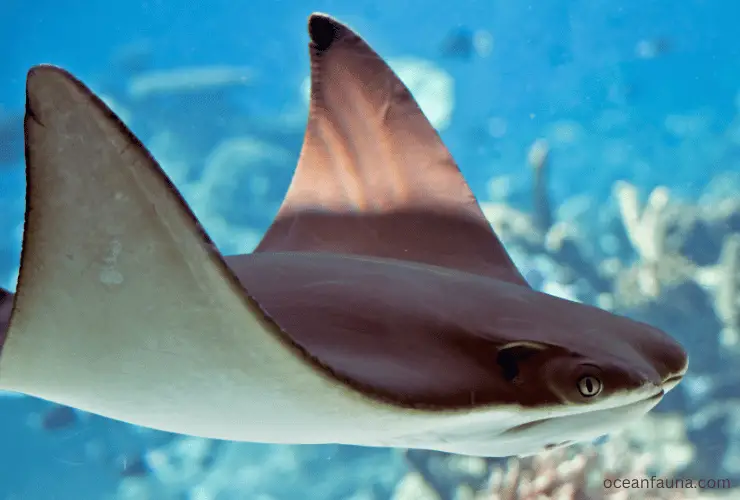
Conversely, stingrays feed on various small invertebrates, including mollusks, crustaceans, and worms. They use their specialized mouth on the underside of their body to dig in the sand in search of food.
Stingrays feed mainly at night and are more likely to be found buried in the sand during the day. Both manta rays and stingrays are opportunistic feeders and will consume whatever food is available in their environment.
However, their diets reflect their different adaptations and behaviors, with manta rays feeding mainly on plankton and small fish and stingrays feeding on small invertebrates.
Lifespan
The lifespan of manta rays and stingrays can vary depending on the species, but the two groups have some general differences.
Manta rays are known to have a relatively long lifespan, with some species living for more than 20 years in the wild. This long lifespan allows them to grow to a large size and reproduce multiple times throughout their lives.
On the other hand, stingrays have a shorter lifespan, typically living for about 10 to 15 years in the wild. This shorter lifespan is partly due to the greater risks that stingrays face from predators and fishing pressure.
This difference in lifespan is likely related to the different adaptations and behaviors of these two groups of animals.
Intelligence
The intelligence of manta rays and stingrays needs to be better understood, as they belong to different species and have different brain structures.
However, both manta and stingrays are considered relatively intelligent for fish species, with the manta ray being considered the more intelligent of the two due to its larger brain size and complex social behavior.
Rays have good memory and problem-solving abilities, but more research is needed to understand their cognitive abilities better. It is also worth noting that intelligence manifests differently in different species and cannot be directly compared.
Population and Distribution
The exact worldwide population of manta rays is unknown, but it is estimated to be in the tens of thousands. Manta rays are widely distributed throughout tropical and subtropical waters of the world, with populations found in the Atlantic, Indian, and Pacific Oceans.
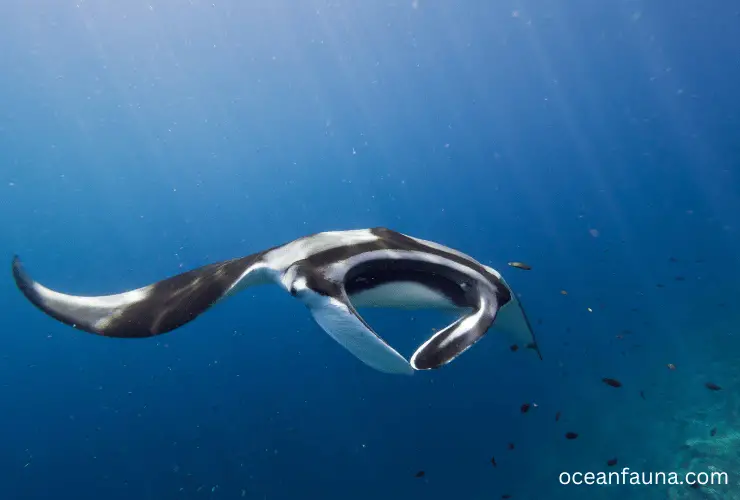
They are most commonly found near coastlines and in shallow waters near coral reefs and seamounts. Manta rays are considered vulnerable to extinction, with populations declining due to overfishing and habitat loss.
The worldwide population of stingrays has yet to be discovered. There is no accurate estimate of the total number of stingrays in the world’s oceans. Stingrays are widely distributed in oceans and seas throughout the world, from shallow tropical waters to deep offshore environments.
They can be found in the Atlantic, Pacific, and Indian Oceans and in the Caribbean, Mediterranean, and Red Seas. Some species have a limited distribution, while others are more widespread.
They are commonly found in nearshore habitats such as bays, estuaries, and coral reefs but can also be found in open ocean environments.
Environment
Manta rays live in the open waters of tropical and subtropical oceans, typically near the surface. They are often found near coastlines, coral reefs, and oceanic islands.
Mantas are migratory animals that move to warmer waters during the winter and return to cooler waters during the summer.
They prefer environments with abundant food, such as plankton and small fish, which they feed on by swimming with their mouths open and filtering the water as they go. Mantas are also known to congregate in areas where small fish and other marine animals can clean them.
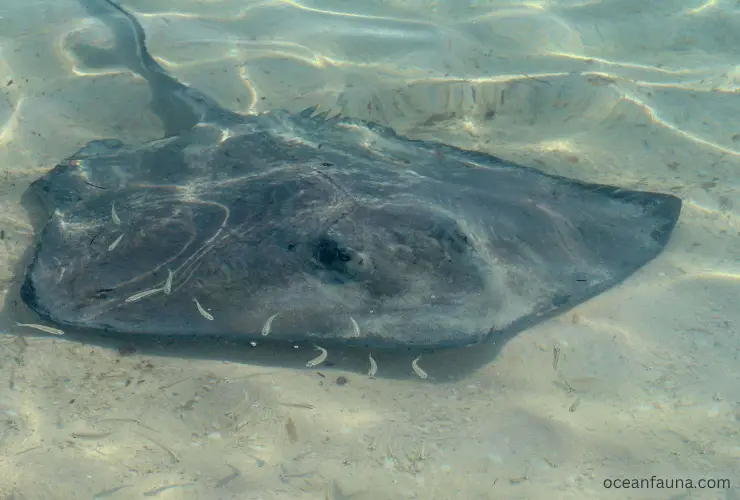
On the other hand, Stingrays are mainly found in warm, shallow waters in tropical and subtropical regions. They are commonly seen in saltwater environments like bays, estuaries, and lagoons.
Some species of stingrays can also be found in brackish waters, where the salinity levels are intermediate between freshwater and seawater. Some species, like freshwater stingrays, can be found in rivers and streams.
Stingrays prefer sandy or muddy bottoms and often bury themselves in the substrate, making it hard to spot them.
They feed on small mollusks, crustaceans, and fish and are generally harmless to humans unless provoked. Stingrays play an essential role in maintaining the ecological balance in their environment.
Number of Species
There are two species of manta rays, the giant manta ray (Manta birostris) and the reef manta ray (Manta alfredi). If we look at how many species the sting ray has, it has more than 220 species.
Mating Seasons of Manta Rays and Stingrays
The mating seasons of manta rays and stingrays differ based on their species and geographic location. Manta rays have a prolonged mating season that can last several months, usually between October and January, in the Indo-Pacific region.
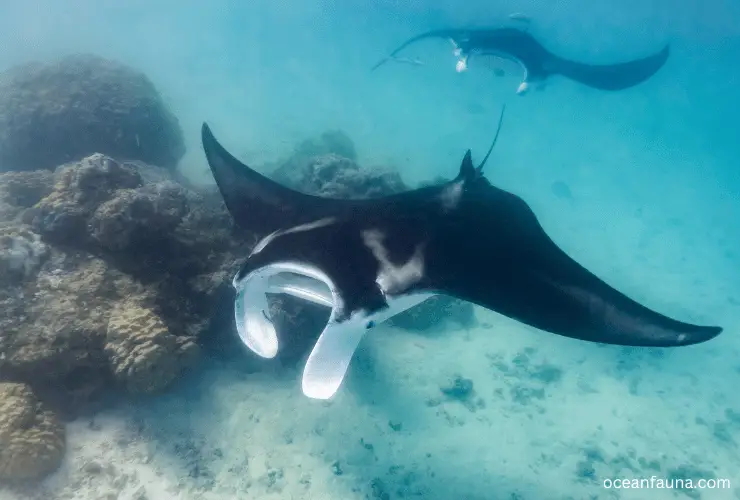
They gather in large groups to mate and give birth during this time.
On the other hand, the mating season of stingrays varies greatly based on their species. Some species mate year-round, while others have a specific mating season that can last anywhere from a few weeks to several months.
In some regions, such as the Gulf of Mexico, the mating season of stingrays occurs in the summer months, like May and July.
Both manta rays and stingrays are oviparous, meaning that the females lay eggs. However, the exact reproductive strategies can vary between species, including internal fertilization or fertilization in the water column.
FAQs
What’s Bigger Manta Ray or Sting Ray?
Manta rays are generally larger than stingrays. Manta rays are the largest species of ray and can reach up to 23 feet (7 meters) in width, while stingrays typically grow to be around 2 to 3 feet (0.6 to 1 meter) in width.
A manta ray can be much more giant than a stingray, making them one of the largest fish species in the ocean.
Is it Safe to Swim with Sting Ray?
Swimming with stingrays can be safe if proper precautions are taken. Stingrays are generally shy and will avoid contact with humans if given a chance. However, they can react defensively if they feel threatened or are accidentally stepped on, resulting in a string.
What Happens if a Sting Ray Touches You?
If a stingray touches you, it may use its tail to defend itself, which can result in a string. A venomous barbed spine causes the sting from a stingray on its tail. This can cause pain, swelling, redness, and sometimes nausea, vomiting, and fainting.
In rare cases, the sting can also lead to serious injury or infection, especially if the wound is not properly cleaned and treated.
If you are stung by a stingray, rinse the affected area with vinegar or hot water, remove any visible spines, and seek medical attention if necessary.
Can Manta Rays and Sting Rays Kill You?
A stingray or manta ray is not likely to kill a healthy adult, but a sting from a stingray can be painful and cause serious injury in rare cases.
The venom from a stingray’s tail spine can cause pain, swelling, and other symptoms, and in some cases, it can lead to an allergic reaction, which can be life-threatening.
However, manta rays are generally not considered dangerous to humans and do not have stingers. They are generally docile and do not pose a threat to humans.
Do Manta Rays and Sting Rays Have Bones?
Yes, manta and stingrays have skeletons, but their skeletons differ from most vertebrates. Manta rays and stingrays are cartilaginous fish, which means that their skeletons are made of cartilage rather than bone.
Cartilage is a flexible, durable connective tissue that supports and allows movement. This makes it an ideal material for the flexible bodies of manta rays and stingrays.
Conclusion
Manta rays and stingrays are different species of animals and do not have a specific relationship with one another.
They may occasionally share the same habitats, but they do not have any symbiotic or cooperative relationships.
In general, manta rays and stingrays do not interact with one another and go about their own business in the ocean. However, in some cases, manta rays and stingrays may compete for the same food sources or territory.

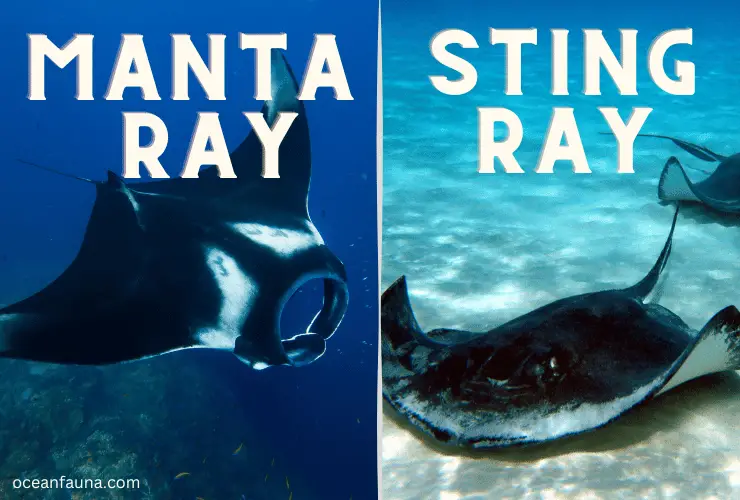
I absolutely love your website.. Very nice colors & theme. Did you develop this website yourself? Please reply back as I’m wanting to create my very own website and want to find out where you got this from or what the theme is named. Many thanks!